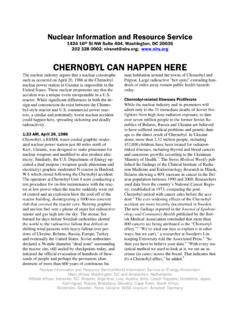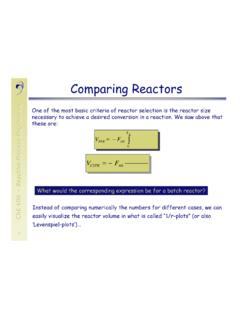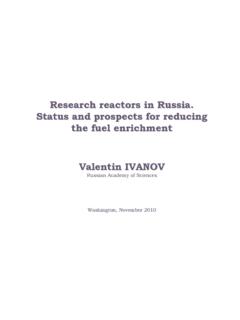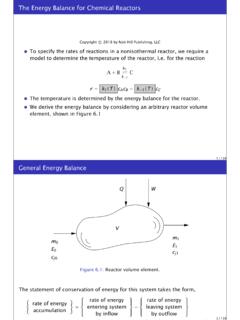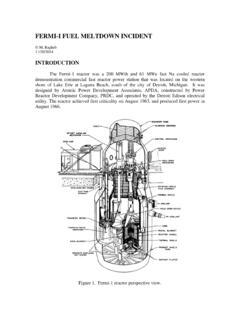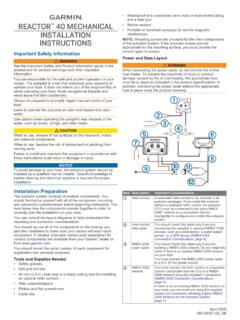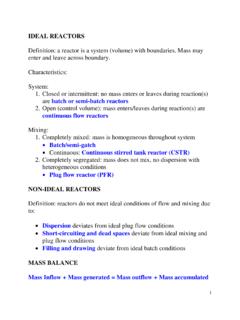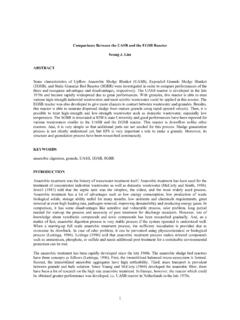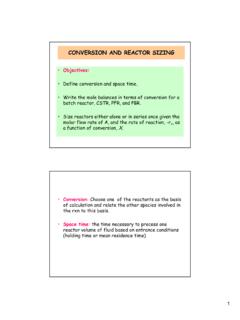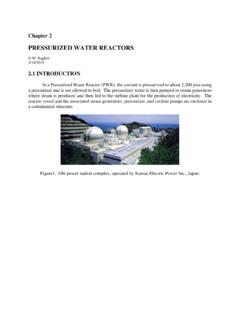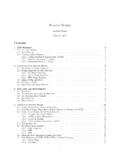Transcription of The EPR nuclear reactor - NIRS
1 Greenpeace an energy revolutionA dangerous waste of time and moneyThe EPR nuclear reactorBriefing January 20122 Greenpeace International EPR: The French ReactorThe French EPR* is a nuclear reactor design that is aggressively marketed by the French companies Areva and EDF. Despite the companies marketing spin, not only is the reactor hazardous, it is also more costly and takes longer to build than renewable-energy no EPR is currently operating anywhere in the world, four reactors are under construction in Finland (Olkiluoto 3, construction started in 2005), France (Flamanville 3, 2007) and China (Taishan 1 and 2, 2009-10). The projects have failed to meet nuclear safety standards in design and construction, with recurring construction defects and subsequent cover-ups, as well as ballooning costs and timelines that have already slipped significantly.
2 * EPR: European Pressurised reactor , sometimes marketed as an Evolutionary Power reactor The EPR nuclear reactor A dangerous waste of time and moneyCountries where the EPR is under construction, where the reactor has been considered but rejected and where earlier plans are being reviewed or have been scaled back (as of January 2012)Plans reviewed/scaled back: India | ChinaUnder construction: Finland | France | ChinaRejected: United States | Canada | United Arab Emirates | South Africa | Italy | Lithuania3 Greenpeace International The EPR nuclear reactorFlawed and risky designThe EPR design, which was supposed to be completed and ready for construction in the early 2000s, remains unfinished.
3 The design has numerous flaws: The EPR is the first reactor design proposed that is to be controlled by fully computerised systems both during normal operation and during accidents. Areva s original design for the computer systems has been found to violate just about every basic principle of nuclear safety, and many regulators are requiring an analogue back-up system. Using several complex software systems to control a nuclear power plant introduces an enormous amount of potential errors and unpredictable interactions. As of November 2011, no approved design of the control systems exists, even though Areva has been working on this system for years.
4 In addition, in many of the EPR components Areva is proposing to use off-the-shelf computer systems that do not comply with nuclear safety standards. The EPR design is not equipped to deal with a sustained blackout of the power supply to the reactor s emergency systems, a crucial design defect that caused the Fukushima nuclear disasters in March 2011. The EPR reactor s emergency diesel generators are insufficient to power many crucial subsystems needed to cool down the reactor . If the diesel generators malfunction, the reactor is designed to prevent a meltdown of the reactor and the nuclear waste ponds for only 24 hours before risking meltdown.
5 In Fukushima, the blackout lasted 11 days. Once cooling is lost, an accident can proceed fast: in the Fukushima reactors, fuel was completely molten 11 hours after the meltdown in constructionThe EPR design is the world s largest nuclear reactor , and one of the most complex. The complexity of the reactor and the constant pressure to reduce costs have led to systematic cutting of corners and to cover-ups of defects in Finland and France, including: substandard concrete quality and quality monitoring; hiring inexperienced and incompetent subcontractors; working without approved blueprints and guidelines; substandard quality of welding work, due to a lack of training and oversight, as well as a lack of mandatory specifications for welding procedures, skipping mandatory quality controls and tests; and deliberately covering up structural defects.
6 In both Olkiluoto and Flamanville, Greenpeace has recorded testimony from workers from the French companies working on the project giving orders to cover up defective concrete structures or to accept quality-control reports that show non-conformance with quality to Finnish and French nuclear regulators, many of these violations have continued through 2011. See page 6 for on EPR construction in Taishan, China is almost non-existent. However, documents describing a set of inspections in 2009 and 2010 by Chinese officials identify a chillingly familiar set of problems, including insufficient supervision, insufficient testing of concrete composition, hiring of inexperienced subcontractors, as well as recurring problems with storage and labeling of virtually all cases of quality problems, Areva s own inspectors have failed to detect violations or have tried to cover them up.
7 As far back as 2006, the Finnish nuclear regulator said that the number of problems was so high that it is possible that not all of them have been detected. Defects left in the final structures can either initiate a nuclear accident, or fail under accident conditions, making matters is trying to write off these design flaws and construction failures as first-of-a-kind problems that the company has now learned from. This is no different from what the company promised before the current failed projects, in a 2005 brochure: The EPR is the direct descendant of the well proven N4 and KONVOI reactors, guaranteeing a fully mastered technology. As a result, risks linked to design, licensing, construction and operation of the EPR are minimised, providing a unique certainty to EPR customers.
8 Increased hazards from accidents and nuclear wasteAn EPR reactor , once in operation, would contain more radioactive substances than any currently operating reactor , three times as much as the first unit in Fukushima Daiichi. This is due to two things: the EPR is the largest reactor in the world, and it is designed to burn uranium more intensely than existing reactors. This causes the amount of readily released radioactive substances in spent fuel to increase. EU-funded research shows that the health risk posed by high-level nuclear waste from the EPR is up to seven times greater than that caused by waste from existing reactors. This has the potential to expose the public to unforeseen short- and especially long-term health hazards, as well as to enormous uncovered liabilities, since current nuclear waste disposal plans are not adequate to accommodate the more dangerous nuclear waste from the EPR.
9 If there is an accident in an EPR reactor , or in transporting spent fuel from an EPR, the radioactive releases and health impacts would be much larger than typical releases from currently operating EPR nuclear reactor : A dangerous waste of time and money is an update of the 2008 Greenpeace International briefing on this reactor . We have added some of the many new design and construction errors and the economic setbacks the EPR has run into. We also include more information on the tremendous gains in the cost performance of renewable energy and the increase level of International The EPR nuclear reactorSpent fuel pool Lacks precautions against the kinds of hydrogen explosions that happened in Fukushima.
10 Sustained loss of power to cooling systems could cause fuel to melt and lead to massive leakage and contamination. The pool is located outside the reactor containment and is vulnerable to attacks, including aircraft base-slabFailure can affect a power plant s stability and lead to release of radioactivity in an accident. Olkiluoto 3: Concrete mixture was improper, with water content too high, leading to high chemical vulnerability and danger of cracking. Concrete samples disappeared from the 3: Concrete mixture did not meet required standards, and base-slab has already developed cracks. Reinforcing steel bars were either arranged and welded improperly, or were completely missing.

